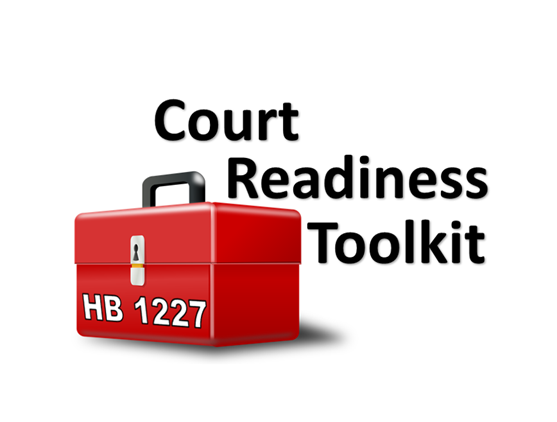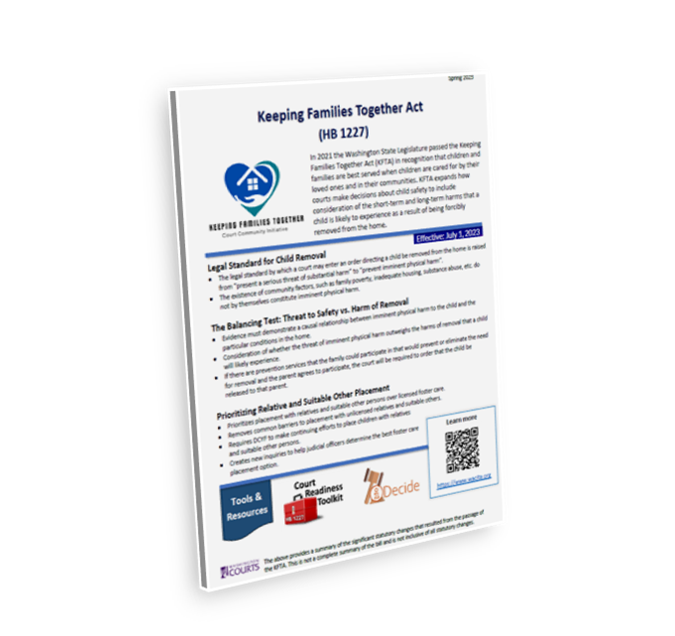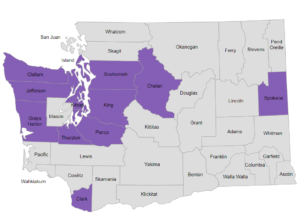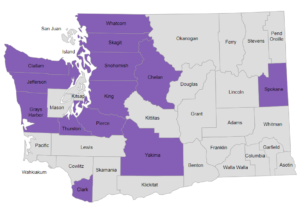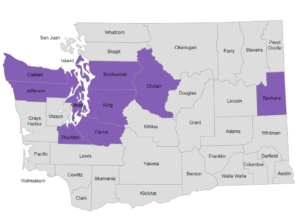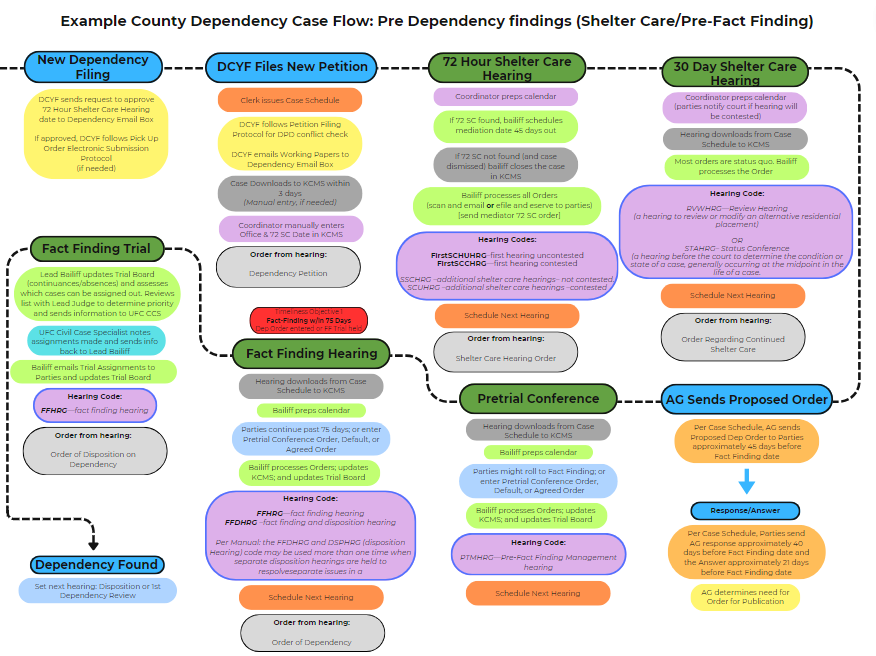In 2021 the Washington State Legislature passed the Keeping Families Together Act in recognition that children and families are best served when children are cared for by their loved ones and in their communities.
The Keeping Families Together Act became effective on July 1, 2023.

The Keeping Families Together Act made fundamental changes the front-end of the dependency court system process (i.e., Shelter Care). Passage of this legislation was driven by a number of factors, including the continued overrepresentation of Black and Indigenous children in the child welfare system and an acknowledgement that, even in cases of abuse and neglect, forcibly removing a child from their home is inherently traumatic. Through expanded judicial authority, the Keeping Families Together Act aimed to support the creation of a more equitable Shelter Care process that results in better outcomes for all families, such as fewer removals, increased kinship placements (vs. foster care), and reduction of racial disparities. The Keeping Families Together Act will likely have many significant impacts on dependency court system process and practice. Family & Youth Justice Programs (FYJP) worked in partnership with our cross-system partners (see Family Well-Being Community Collaborative) for over two-years to analyze the impacts of the new law and create practical tools, training, and resources to support court systems in effectively implementing this historic legislation.
Jump to…

Below is a summary of the significant statutory changes that resulted from the passage of the Keeping Families Together Act. This is not a complete summary of the bill and is not inclusive of all statutory changes.
Legal Standard for Child Removal
The Keeping Families Together Act raised the standard by which a court may enter an order directing a child be removed from the home to prevent “imminent physical harm“. It also created a requirement that the court shall release a child to a parent at the Shelter Care Hearing unless the court finds that removal of the child is necessary to prevent imminent physical harm. Further, the Keeping Families Together Act added into law that the existence of community or family poverty, isolation, single parenthood, age of the parent, crowded or inadequate housing, substance abuse, prenatal drug or alcohol exposure, mental illness, disability or special needs of the parent or child, or nonconforming social behavior does not by itself constitute imminent physical harm.
“Poverty should never be a reason for removing children from homes.”
Rep. Lillian Ortiz-Self, D-Everett (Bill Sponsor)

The Balancing Test: Threat to Safety vs. Harm of Removal
The Keeping Families Together Act created the requirement that the evidence of imminent physical harm clearly demonstrate a causal relationship between imminent physical harm to the child and the particular conditions in the home. Using that evidence, courts then consider whether the danger of imminent physical harm posed by the conditions in the home outweighs the harms of removal that a child will likely experience.
The Keeping Families Together Act also added mandatory consideration of whether there are any “prevention services“, including housing assistance and other reasonably available services, that the family could participate in that would prevent or eliminate the need for removal. Courts will consider whether there are services or supports that could be put in place that would prevent or eliminate the need for removal while the family continues under court jurisdiction, and if the parent agrees to participate in those services, the law requires the court to order that the child return/remain home. The goal of this statutory change is to help courts ensure that forcible child removal is used only as the option of last resort to ensure child safety.

“I have seen their anguish and trauma… and their desire to be reunified with their families. Which screams to me that we should be doing everything in our power to make sure that [removal] is the absolute last resort.”
Rep. Lillian Ortiz-Self, D-Everett (Bill Sponsor)
Prioritizing Relative and Suitable Other Placement
The Keeping Families Together Act expanded the judicial role in determining placement for children who have been ordered into out-of-home care. If removal is determined necessary to ensure child safety, the new law now contains a presumption of placement with relatives and suitable other persons (kinship care) and placed the burden on the State to show why placement in licensed foster care is needed. The Keeping Families Together Act changes the law in ways that seek to reduce some of the commonly observed barriers to kinship placements, such as changing restrictions around incomplete background checks and creating an expedited foster care licensing process for kinship caregivers. In addition, DCYF is now required to make continuing efforts to place children with relatives and suitable other persons throughout the life of a case until permanency is achieved.
When placement with a relative or suitable other is not possible, the Keeping Families Together Act created new inquiries to help judicial officers consider the foster care placement option that keeps children safely connected with the people, places and things most important to them, such as proximity to the parent(s) and ability to remain in the same school district.


Preparing Dependency Courts
Family & Youth Justice Programs (FYJP) created the Keeping Families Together Court Community Initiative to prepare WA dependency courts systems for implementation of the new law, with particular attention paid to ensuring that courts understand and apply the new law. This initiative was part of the work being done by the Family Well-Being Community Collaborative (FWCC), which facilitated multiple cross-system workgroups dedicated to creating practical solutions for successfully implementation of the Keeping Families Together Act. Workgroups met on a consistent basis to crosswalk statutory changes with current dependency law to identify the new legal standards, inquiries, findings, and changes in current process that resulted from the new law (see workgroup HUBs for more information). These “statutory crosswalks” provided the foundation for the tools, resources, and trainings that were developed to support courts in this historic legislative change (below)
Tools & Resources
- Emergency Removal Statutory Crosswalk
- Removal Decisions Statutory Crosswalk
- Placement Decisions Statutory Crosswalk
- Family Time Visitation Decisions Statutory Crosswalk (HB 1194)
The HB 1227 Court Readiness Toolkit contains a suite of tools and resources to help court systems prepare for implementation.
iDecide was created by FYJP as a web-based application to support successful implementation.
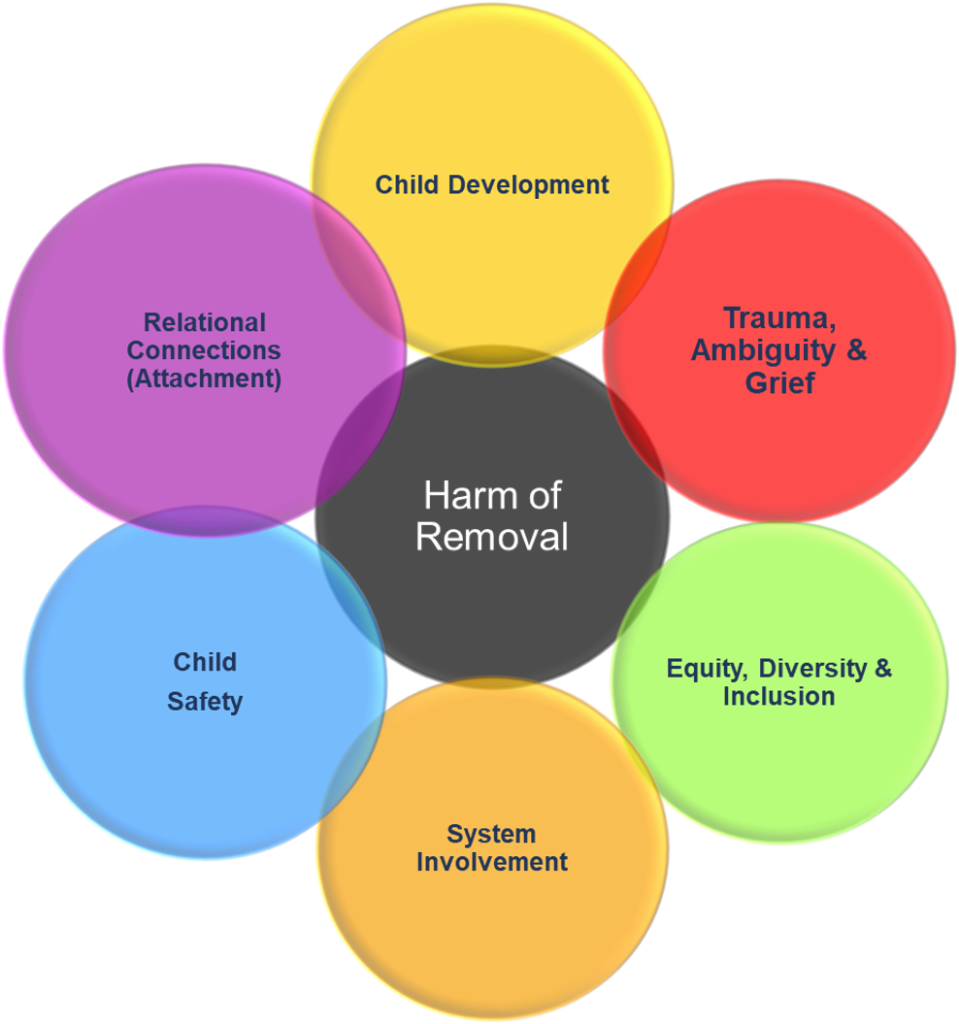
Check out the tools and training that has been developed to support court systems in understanding harm of removal.
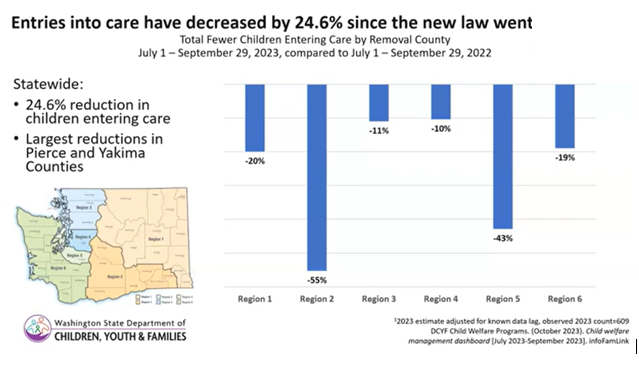
DCYF has developed reporting to inform the implementation of the removal standards under HB 1227 on entries in to care. The most recent data and future updates are available on the DCYF website.
Training
Check out the Events Calendar to see upcoming training events.
On-Demand Training
Behind the Bill: Keeping Families Together Group Fishbowl Conversation
60 minutes
Hear from members of the Keeping Families Together Group on the intent, purpose, and goals of the Washington State Legislature in passing the Keeping Families Together Act.
Statutory Overview of the Keeping Families Together Act
70 minutes
Overview of the statutory changes contained within the Keeping Families Together Act legislation.
Child Safety and Harm of Removal
45 minutes
Learn about the short-term and long-term harms that children experience when they are removed from the home and the balance of those harms against child safety in removal decisions.
Safety Planning in Action: Collaborative Safety Planning in Snohomish County
90 minutes
Joint presentation from parent attorneys, parent allies, and DCYF staff in Snohomish County about how their dependency court system collaborates to create safety plans that allow families to safely remain together.
Kin-First Culture
60 minutes
Hear about the different kin-first culture initiatives at DCYF and learn about the unique needs of kinship caregivers, including the resources available to kinship caregivers.
Past Training Events
2023 Dependency Judicial Training Academy
5/5/2023 – 5/7/2023
Keeping Families Together Act (HB 1227): Basics for the Bench
8/10/2023 – 8/11/2023
Cross-System Kickoff for the Keeping Families Together Act
Region 1
Counties: Pend Oreille, Spokane, Whitman, Adams, Grant, Douglas, Chelan, Okanogan, Ferry, Lincoln, Stevens
Date: 5/5/2023
Time: 12:00 – 1:15pm
Cross-System Kickoff for the Keeping Families Together Act
Region 2
Counties: Asotin, Benton, Columbia, Franklin, Garfield, Kittitas, Klickitat, Walla Walla, Yakima
Date: 5/30/2023
Time: 12:00 – 1:15pm
Cross-System Kickoff for the Keeping Families Together Act
Region 3
Counties: Whatcom, Skagit, Snohomish, Island, San Juan
Date: 5/19/2023
Time: 12:00 – 1:15pm
Cross-System Kickoff for the Keeping Families Together Act
Region 4
King County
Date: 6/6/2023
Time: 12:00 – 1:15pm
Cross-System Kickoff for the Keeping Families Together Act
Region 5
Counties: Pierce and Kitsap
Date: 5/11/2023
Time: 12:00 – 1:15pm
Cross-System Kickoff for the Keeping Families Together Act
Region 6
Counties: Thurston, Lewis, Skamania, Klickitat, Clark, Cowlitz, Wahkiakum, Pacific, Grays Harbor, Mason, Jefferson, Clallam
Date: 5/9/2023
Time: 12:00 – 1:15pm
